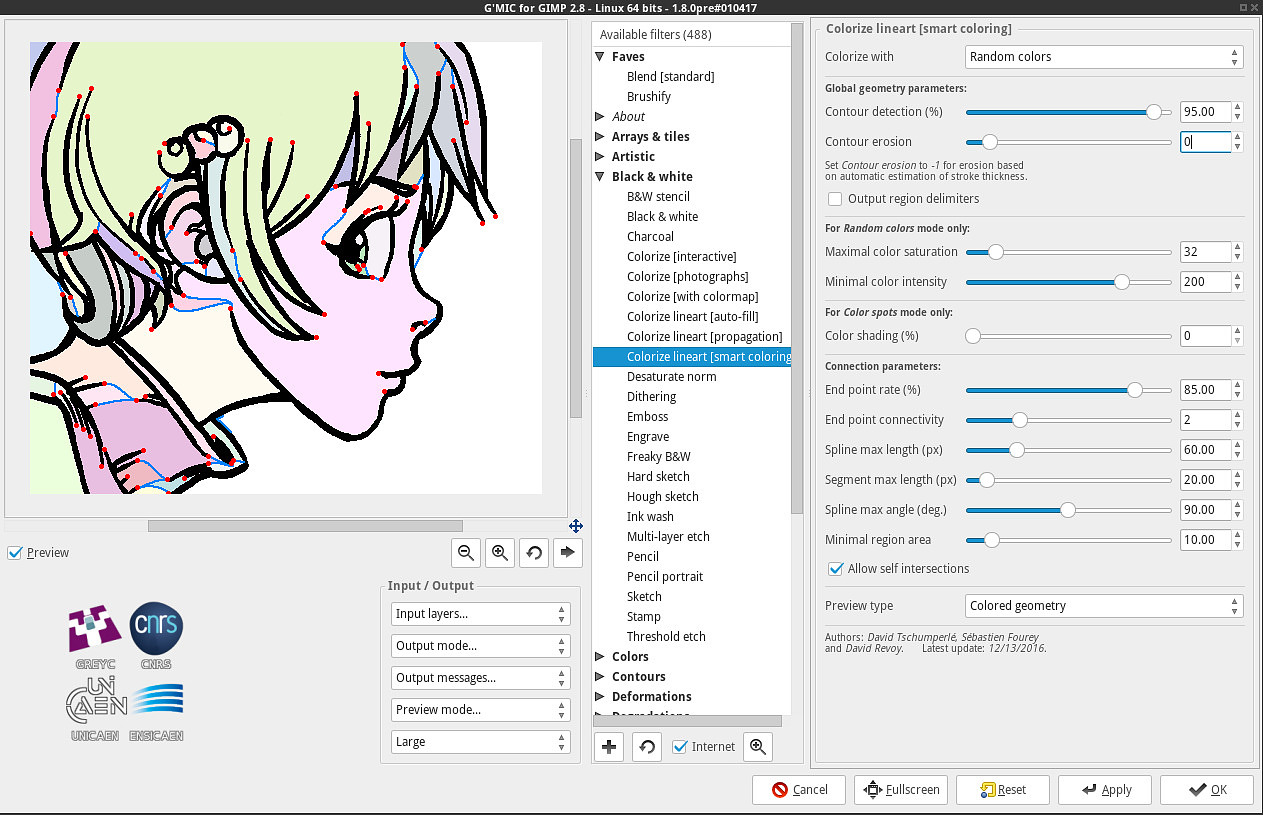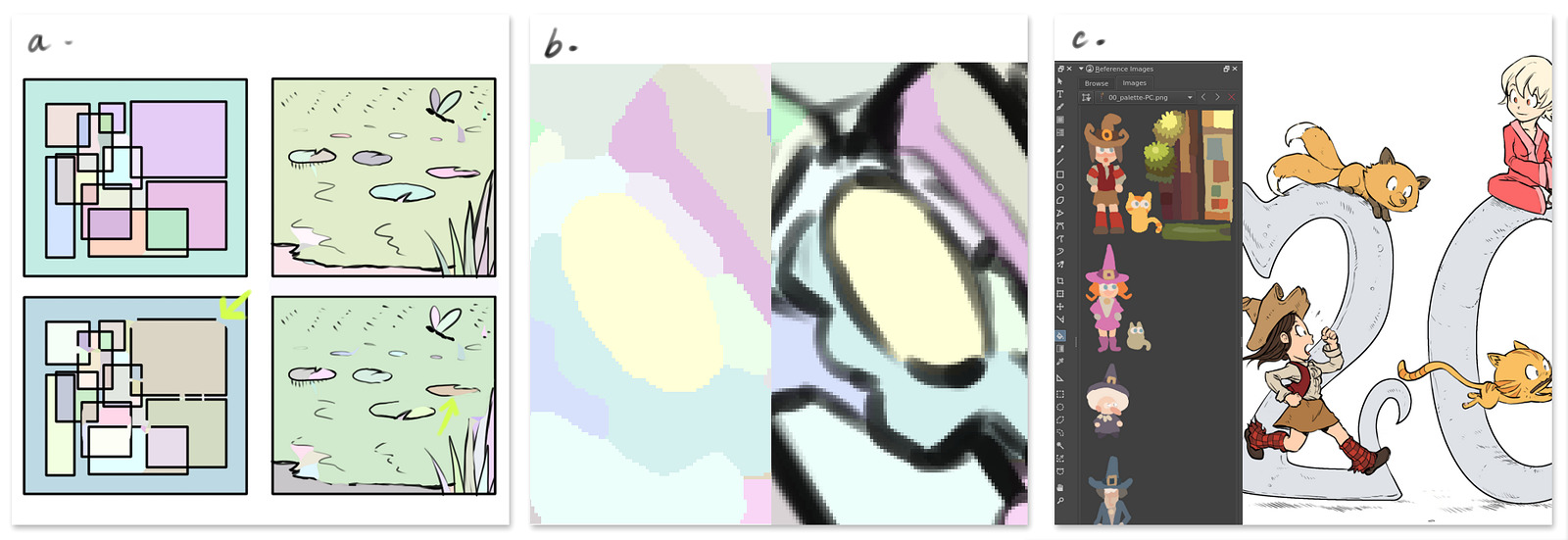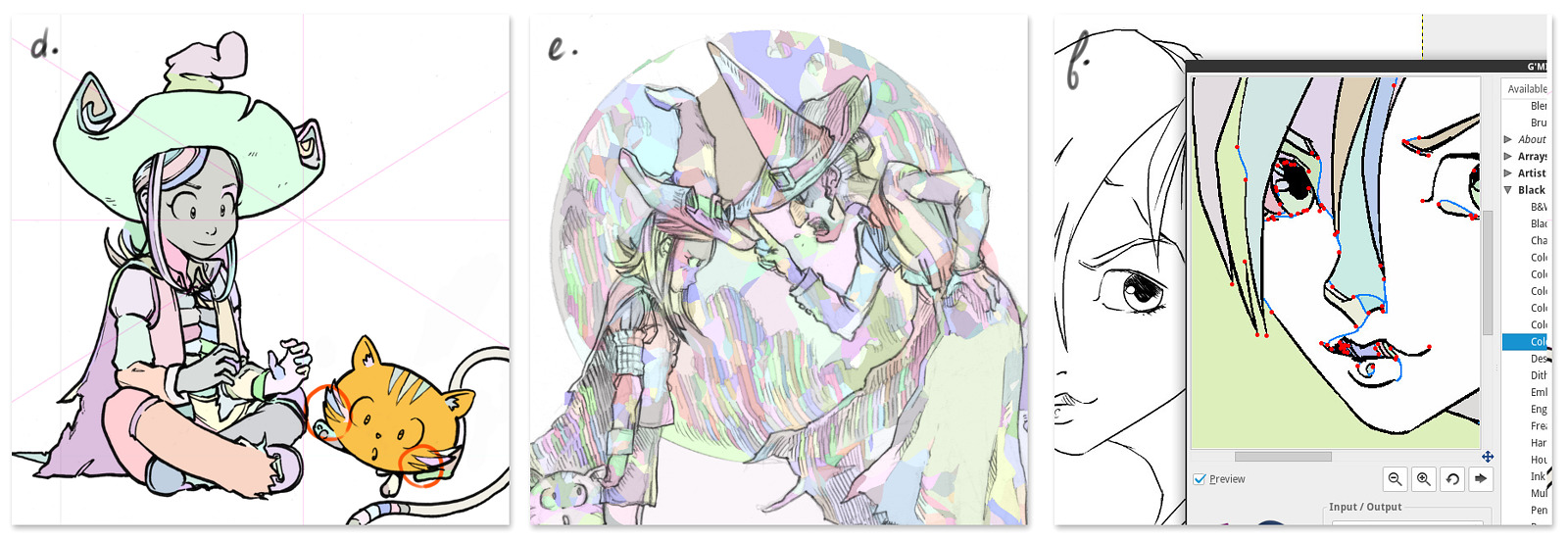Tips for using Smart-Coloring GMIC filter
Here are my notes about the Colorize Lineart[smart coloring], a new GMIC filter to auto-colorize line-art created by David Tschumperlé, Sébastien Fourey and me. The workflow of this filter is really simple as you can see on the picture of the top:
- Open your black and white line-art
- Send it to the GMIC filter Black&White > Colorize Lineart[smart coloring] the filter will auto-colorize all the areas for you with random bright colors and split two layers: your line-art above the generated color-map.
- Open the result (the filter is really quick) in your digital-painting program, and flood-fill/replace the colormap areas with the colors of your choice.
- Shade on the top, paint, color-corrections and voilà!
The filter :
When launching Colorize Lineart[smart coloring] , the preview display red nodes at the end point of each detected lines, then between the nodes a bezier curve in blue is generated to help 'fixing' the tiny holes in the line-art, or fix the artistic 'missing lines' suggested by the artist. When applying the filter, the node in red and the blue lines disapear to let only two layers: the line-art and the color-map.

Pros
- Free/Libre and open-source.
- (a.) Auto-close holes in line-art. ( eg. I made two simple test-artwork: on top with closed lines, on bottom with arbitrary holes in the lines. The filter find the holes, and reconstruct a bezier curved line to smooth the limit. )
- (b.) Result of colormap are clean aliased pure color areas easy to replace with a fill-bucket at low tolerance, with line-art over just perfectly center above it. No problem with the anti-aliasing or bluryness of the line-art (eg. a closeup without the line-art on left, with line-art over it on right ).
- Quick to use, just a filter to launch and quick to compute compare to all the other method I tested.
- (c.) Let you use your digital-painting software for coloring with your tools, palettes, color selections, etc. (eg. I can color in Krita taking advantage of the "Reference Docker" as a palette for color references, also fill-bucket on Krita is super quick and you can click 'Ctrl' to pick color with it at any time , or press 'e' to fill with 'eraser' blending mode, and get full transparency to remove backgrounds.)

Cons
- (d.) Some areas are sometime ignored or merged together. (eg: circled in red, some zone of the fur of the cat Carrot are merged with the body color. This part will need to post-fix the color map with an aliased brush , painting it manually ).
- (e.) Line-art with a lot of crosshatching render with two much little islands on the color-map to use it. it's definitely not a style suited for this filter. (eg. a pencil artwork of Pepper&Carrot episode 11, color map is crazy on the moon in background of the characters.)
- (f.) A limitation of the GMIC Gimp plugin; the preview windows is not really "What You See Is What You Get", it needs a lot of trials and errors for an artist to test the settings (a lot of sliders) and get a setup working with a style.

Install/test
You can already test this filter in GMIC 1.7.9 and 1.8.0beta, I'm using here the GMIC plugin for GIMP, import/export as open-raster *.ora files my line-art and islands to fill and paint them in Krita. For using the filter directly in Krita, we need to wait; last version of Krita 3.1.1 embed only GMIC version 1.7.0.
More informations
Everyone reading my blog already know David Tschumperlé: he is the creator, manager and main developer of GMIC and a good friend. He is a permanent CNRS research scientist, working in the Image group of the GREYC Lab in Caen. Last November, I was invited to join during a couple of day his workplace to work on the research of a "Style transfert" method. Style transfer is a technique to create an image from two sources; -in a nutshell- your holiday best landscape photo and a masterpiece of Vincent van Gogh. The expected result: your holiday photo painted in the style of Vincent van Gogh. Some algorythm already does it, but the results are variable and the existing methods needs a lot of computing time and big databases. At GREYC, the plan is to find a better and more lightweight solution, filter based. As an artist, I was invited to show how I break-down the copy of a painting and give informations on how I perform this "Style transfert" manually as I did on this video.
During this short period of work we had in Caen, I made a conference for scientists at CNRS. At the end of the conference, I presented the making-of episode 12 of my webcomic Pepper&Carrot as a proof-of-concept about merging multi computer tools: filters, scan, 3D, etc.... This episode mix also a lot of GMIC filters and a very old script for GIMP named Multifill. It's a filter I used 6 years ago on my early comic-style test. Unfortunately, with newer version of Gimp, the filter became very buggy, slow and unmaintained. David was surprised to learn that it took hours for this filter to auto-floodfill all the potion on episode 12. Two hours after the conference, he made a version of Multi-Fill in GMIC named Colorize lineart[auto-fill]. His filter matched the same work than 'Multifill' but in less than 30seconds! A couple of discussion later in front of a "Coloring Pages" hanging on the wall and colored by a kid of the crew, we started to share common issues of automatic coloring filter and what method exists to colorize black and white line-art. The work on the new filter Colorize Lineart[smart coloring] came later after I came back home. I started testing it and giving feedback while David Tschumperlé and Sébastien Fourey kept improving it.
Gallery
I'm still testing the filter. A single panel of comic here, a little artwork there. Here is a gallery of recent works made with it.

Your feedback?
A lot of digital artists reads my blog ; so question for you: what do you think about this new method? Do you think it can save you time when coloring your line-art? Would you plan to use it? Do you have a quicker method? Let me know on the comments.

